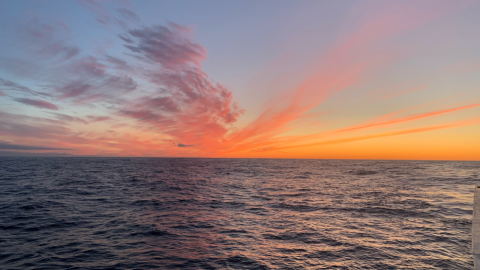Why is it important?
Oxygen is important for all living organisms: not only on land, but also in the sea. Marine plants, such as phytoplankton and kelp, convert carbon dioxide into sugars (carbohydrates) and oxygen using the sun’s energy through photosynthesis. These marine plants produce at least half of the oxygen in the atmosphere (estimates range between 50 - 85%). Marine animals rely on the oxygen that is dissolved in sea water for respiration, through diffusion into their body tissue (such as jellyfish and starfish) or via their gills (such as fish and molluscs). Dissolved oxygen concentrations in the North Sea are typically between ~6 mg l-1 (~192 µmol kg-1) and ~10 mg l-1 (~320 µmol kg-1; Mahaffey et al., 2020). Disastrous impacts can occur when dissolved oxygen concentrations fall below a threshold of 2 mg l-1 or 64 µmol kg-1, resulting in hypoxia. These impacts can range from affecting metabolic processes in individual organisms to changes in community structure, and even mass mortality events, in the marine environment, depending on the extent and duration.
What is already happening?
The concentrations of oxygen dissolved in seawater have been declining in the global ocean due to anthropogenic pressures. A side effect of eutrophication is the decline in dissolved oxygen. Anthropogenic climate change has also led to a reduction (Mahaffey, Palmer, Greenwood & Sharples, 2020; Pörtner et al., 2019). This change is due to two factors: (1) a reduction in solubility due to ocean warming, and (2) intensified stratification (see Climate change - Stratification) limiting the air-sea gas exchange of oxygen. This is because less oxygen can dissolve in warmer water, and because more intense stratification limits the transport of well-oxygenated surface waters (due to photosynthesis and dissolution of atmospheric oxygen) to deeper waters (without photosynthesis) where oxygen is consumed and needs to be replaced (also known as ocean ventilation).
Monitoring of dissolved oxygen concentrations in Scottish waters is primarily driven by national and international assessments of ecosystem health (such as eutrophication monitoring). However, monitoring is not sufficiently widespread or often to allow for a confident assessment of trends across all regions of the Scottish coastal and offshore regions (Mahaffey et al., 2020; see Case study: Dissolved oxygen).
However, near-bed oxygen concentrations the North Sea have generally been well observed. Currently, some of the stratified areas of the North Sea experience dissolved oxygen saturation down to 70% (180 µmol kg-1; Queste, Fernand, Jickells & Heywood, 2013) between June and September. Time series show a decline in the oxygen concentration since 1990 in the stratified regions of the North Sea due to both a decrease in solubility resulting from warming and due to an increase in oxygen utilisation from changes in activity rates of plankton and bacteria and their community structure (Queste et al., 2013).
Computer simulations can help address some of the gaps in observations, although there is still discussion on whether these represent the processes that influence oxygen concentration sufficiently well. A study by Ciavatta, Kay, Saux-Picart, Butenschön, and Allen (2016) showed that oxygen concentrations below 6 mg l-1 do occur in some of the coastal areas around Scotland (Forth, Clyde and south of Mull). This is in general agreement with the results presented by the see Case study: Dissolved oxygen.
What is likely to happen in future?
In future, temperatures are expected to rise, and the vertical structure of the water column is expected to show intensified stratification for longer periods of time (Mahaffey et al., 2020). This will lead to oxygen loss due to the reduced solubility and due to reduced ocean ventilation in stratified regions, where the near-bed layer will be most impacted. In addition, biological processes, storminess, resuspension of sediment, precipitation patterns and river inputs are expected to change, but the net effect of these on dissolved oxygen are uncertain.
Oxygen depletion has a severe impact on marine organisms due to the impact on metabolic processes (Mahaffey et al., 2020). Together with ocean warming, the viable habitat for a number of species, including commercially important ones such as marine fish, will change. There is also a chance that changes in the oxygen concentration will have an impact on the biogeochemical cycles of other elements, such as nitrogen, phosphorous and iron, which may encourage further oxygen consumption (leading to loss), but exact impacts remain unknown (Grégoire, Gilbert, Oschlies & Rose, 2019). Similarly, the exact impacts on organisms and ecosystems remain difficult to quantify as there is no specific oxygen concentration threshold, but instead considerable variability occurs due to differences in traits (such as mobility, life cycles, physiological tolerance and metabolism). Vaquer-Sunyer & Duarte (2008) combined studies from across a number of marine benthic habitats to show that fish and crustaceans would be most vulnerable during a low oxygen event.
As in the atmosphere and on land, anthropogenic climate change has an impact on the physical environment of the ocean. Public awareness often emphasises warming ocean temperatures, rising sea-levels and ocean acidification, but the impacts extend further. These include changes to the salinity and oxygen concentration of seawater, the currents, waves, storms, coastlines and water column stratification. This section summarises current knowledge of the impacts of climate change that have already been observed and provides an outlook on how conditions are likely to change in future from climate projections.


